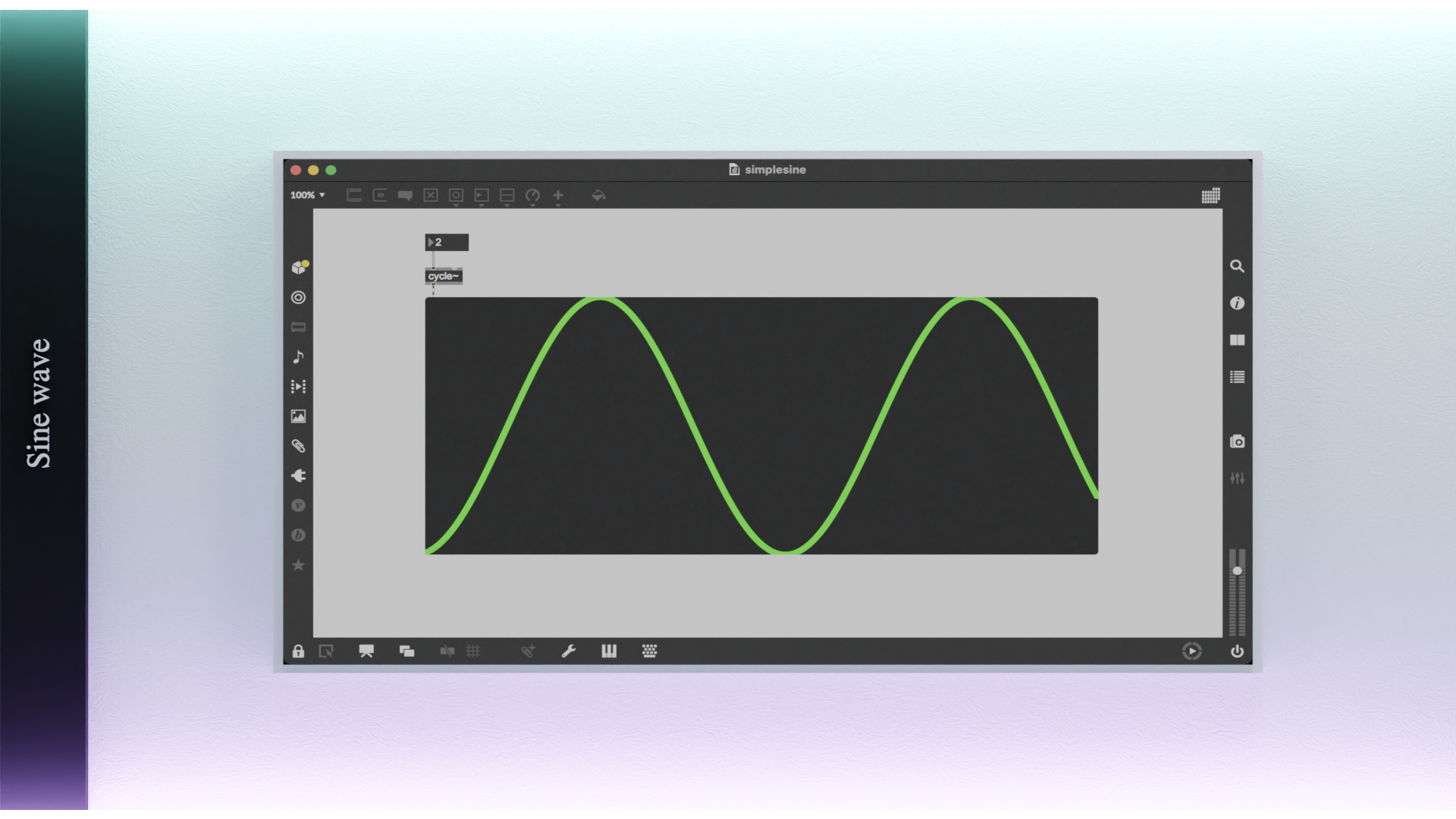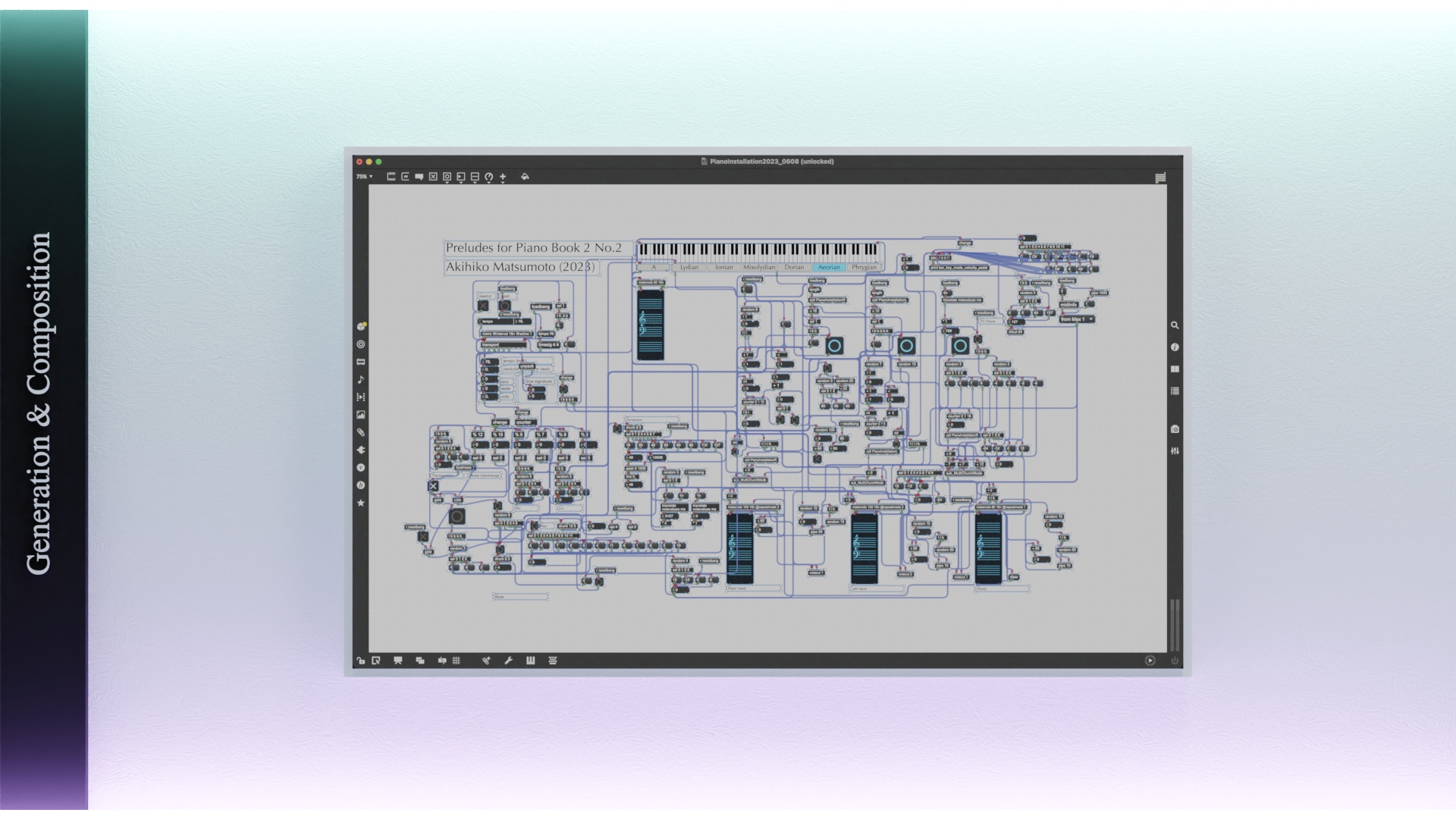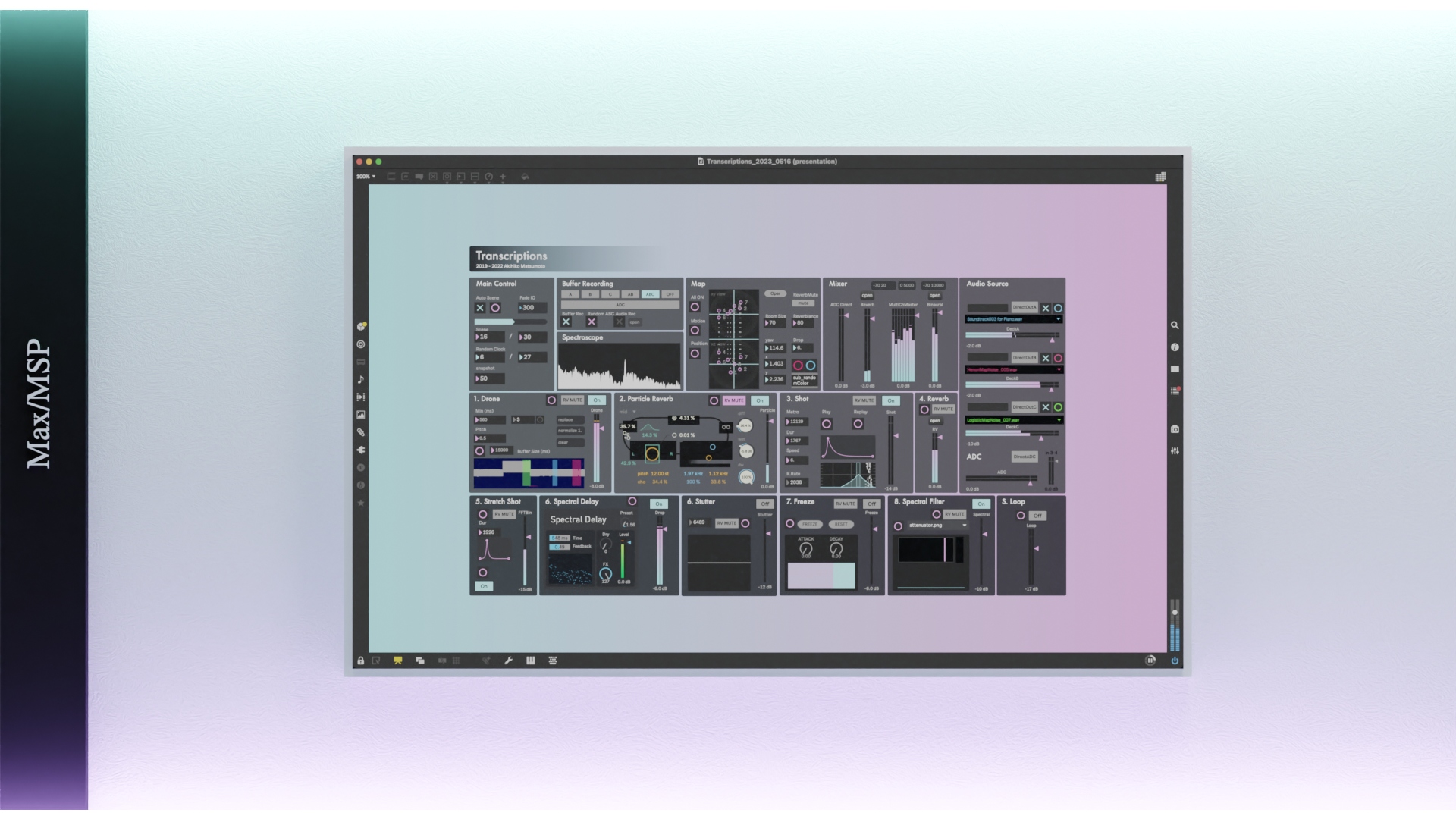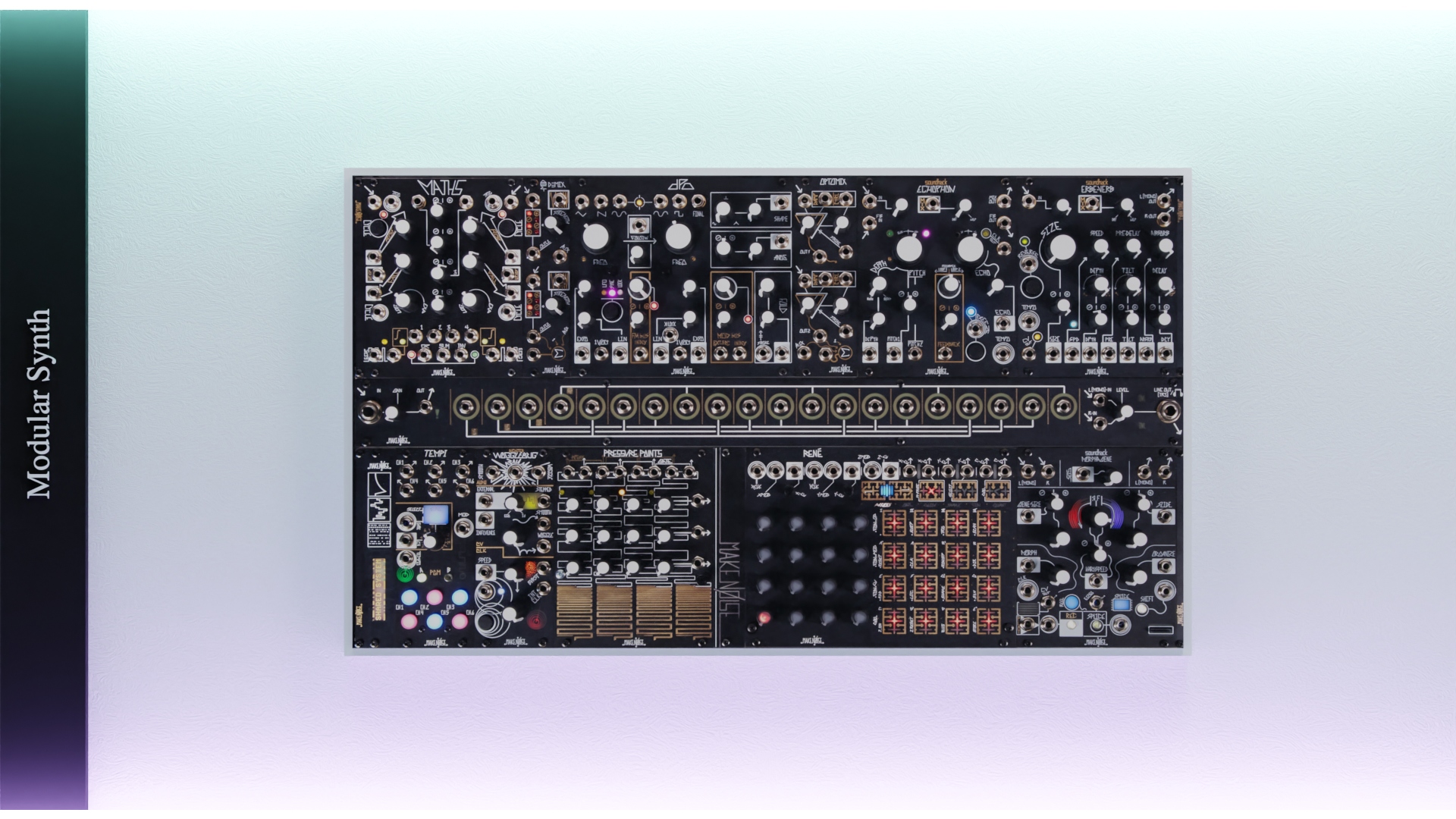
Steve Reich's Phasing
The term phasing, pioneered by composer Steve Reich, is not a common term even among music people, and may be a technique known only to a few people interested in contemporary music. In the 21st century, with the development of electronic technology, phaser, an effect pedal that generates a modulation effect by shifting phase, which is common on guitars and electric pianos, may be more familiar to you.
In this page, through the analysis of the technique and harmony of Reich's 1967 work Piano Phase, I will introduce the actual application of phasing and moiré to compositional techniques, and furthermore, I will reproduce the phasing technique using Max/MSP and consider the possibility of algorithmic composition on the PC and the originality that lies beyond that.
作曲家、スティーブ・ライヒが開拓したフェイジングという言葉は音楽をやっている人にも決して一般的な用語ではないので、現代音楽に興味がある一部の人にしか知られていない技法かもしれません。 むしろ、電子技術が発展した21世紀現在ではギターやエレクトリックピアノで一般的な位相をシフトさせてモジュレーション効果を発生させるフェイザーというエフェクターのほうが馴染みがあるかもしれません。
このページではライヒの1967年の作品Piano Phaseの技法や和声の分析を通じて、フェイズ、モアレを作曲技法に応用する例を紹介し、さらにはMax/MSPを用いてフェイジングの技法を再現し、パソコンにおけるアルゴリズム作曲の可能性とその先にあるオリジナリティについて考えてみたいと思います。
Steve Reich
スティーブ・ライヒ (1936- )
Steve Reich is an American composer of contemporary music. Reich's music makes extensive use of
phases and repetitions, and has long made use of tape sampling and other techniques. Reich
received a Bachelor of Arts degree in Philosophy from Cornell University in 1957, and also
attended the Juilliard School of Music in New York from 1958 to 1961.
From 1961 to 1963, he studied composition at Mills College with Luciano Berio and Darius
Milhaud. He also studied drumming at the University of Ghana's Institute of African Studies in
1970 and Balinese gamelan in Seattle from 1973 to 1974, actively studying the folk music of
various regions.
スティーヴ・ライヒはアメリカの現代音楽の作曲家。ライヒの音楽はフェイズや反復を多用するため、テープによるサンプリングなどが古くから利用されています。ライヒは1957年にコーネル大学哲学科で芸術の学士号を取得した後、1958年から1961年までニューヨークのジュリアード音楽院にも在籍しています。
1961年から1963年までは、ミルズカレッジでルチアーノ・ベリオとダリウス・ミヨーの元で作曲を学んでいます。また、1970年にはガーナ大学アフリカ研究所でドラミングを、1973年から1974年にかけてシアトルでバリ島のガムランの研究も行っており、各地の民族音楽も積極的に吸収しています。
- Come Out tape (1966)
- Piano Phase for two pianos, or two marimbas (1967)
- Pendulum Music for 3 or 4 microphones, amplifiers and loudspeakers (1968)
- Clapping Music for two musicians clapping (1972)
- Music for 18 Musicians (1974–76)
- Come Out tape (1966)
- Electric Counterpoint for electric guitar or amplified acoustic guitar and tape (1987, for Pat Metheny)
Works
etc...
Phasing
フェイジング
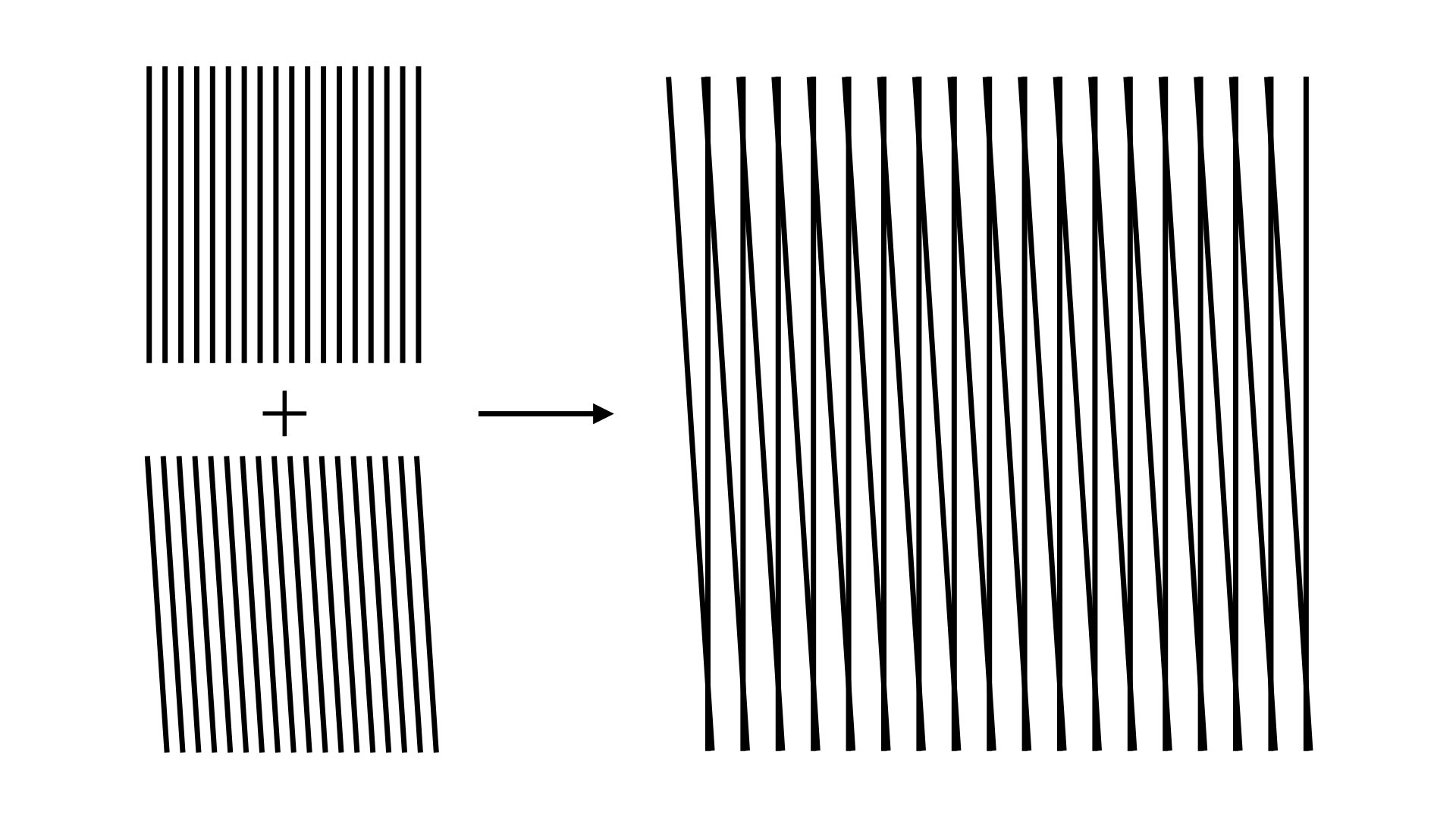
Phasing in music is a technique in which two performers play a single repetitive phrase in slightly different tempo and listen to the changes in sound pattern caused by the interference.
However, it is difficult to imagine what kind of sound it is because the image is too abstract. If we step away from music and think about the phenomenon of moiré in the visual sense, it will be easier to get an idea of what it is. Moire is a phenomenon in which two objects of the same shape are superimposed at slightly different angles, or phases, to produce a certain degree of unpredictable pattern or rhythm. The same can be achieved with sound.
This can be considered a kind of polyrhythm. For example, composer Philip Glass pursues minimalism from a polyrhythmic perspective. Unlike conventional functional harmony, in which the harmony changes in discrete steps, phasing produces an effect in which the sound changes continuously and gently, as if morphing, and before you know it, a musical development takes place.
音楽におけるフェイジングとは、1つの反復的なフレーズを2人の演奏者が微妙に異なるテンポで演奏し、干渉によって生じる音のパターンの変化を聴かせる技法です。
といっても、いったいどのような音なのかイメージが抽象的すぎて難しいと思います。 音楽の話から離れて視覚でのモワレ現象について考えてみるとイメージが湧きやすいと思います。 モワレは同じ形状の2つのものを角度、すなわち位相を少し変えて重ね合わせることである程度予測不可能なパターンやリズムのようなものが生じる現象です。音でも同じことが実現できます。
これは一種のポリリズムと考えることも可能であり、例えば作曲家フィリップ・グラスはポリリズム的な観点でミニマリズムを追求しています。 フェイジングによるハーモニーの変化は、従来の離散的に階段上に和音が切り替わる機能和声とは異なり、モーフィングするかのように連続的になだらかに音響が変化しながらいつの間にか音楽的な展開が行われる効果を生み出します。
Come Out(1966)
Prior to his instrumental works, Reich also utilized this phasing in tape works with electronics, such as Come Out and It's Gonna Rain. Its inspiration comes from medieval music, such as canon.
ライヒは器楽作品に先んじて、Come Out、It's Gonna Rainなどエレクトロニクスを用いたテープ作品でもこのフェイジングを利用しています。その着想は中世音楽のカノンなどから来ています。
Piano Phase(1967)
Piano Phase was written by Steve Reich in 1967 for two pianos and was the first piece in which
Reich applied the phase technique to a live performance.
After Piano Phase, Violin Phase (1967), Phase Patterns (1970), and Drumming (1971) were written
for live performance using similar techniques.
In recent years, performers like Rob Kovacs and Paul David Kean have been playing two pianos by
themselves.
In the case of a piece for two players, at first the two players play the same phrase in unison, but since they play at slightly different tempos, their beats and verses gradually shift, and at the beginning (when the notes are delayed by 32nd notes), the performance sounds as if it is following a note pattern with an echo-like effect.
Next, when the note delay reaches a certain level (sixteenth note), the pulses of the two players
again overlap in time and unison playing reappears.
However, because one player repeats the phrase from a position one note behind the other in the
note pattern, a different dyad (harmony consisting of two pitch classes) emerges from the first,
forming a vertical harmony with a different pitch than the first perfect unison.
The harmony gradually changes with each rhythmic shift, and when the repetition is delayed by a
cycle, it returns to the same perfect unison as at the beginning, and can be developed into a
kind of final form.
Piano Phaseは1967年にスティーブ・ライヒによって書かれた2台ピアノのための楽曲で、ライヒが最初にフェイズの技法をライブパフォーマンスのために適用した楽曲です。
Piano Phase以降、Violin Phase (1967), Phase Patterns (1970), Drumming
(1971)も同様の技法でライブパフォーマンスのために書かれた作品です。
近年ではRob KovacsやPaul David Keanのような演奏家が2台ピアノを1人で演奏しています。
2人の奏者のための楽曲の場合、はじめは同じフレーズを2人でユニゾン演奏していますが、2人は微妙に異なるテンポで演奏を行うため少しずつに2人の拍、節ずれていき、最初の段階(音符が32分音符分遅れた状態)ではエコーのような効果を伴い音型を追いかけるような演奏に聞こえる時間帯が出現します。
次に音の遅れが一定(16分音符分)に達すると再び2人の演奏のパルスが重なる時間帯になりユニゾン演奏が再び出現します。
しかし、一方の奏者は音型の中で音符が一つ分遅れた位置からフレーズを反復演奏しているため、最初とは異なるダイアド(2つのピッチクラスから成るハーモニー)が出現し、最初の完全一度のユニゾンとは異なる音程の縦のハーモニーを形成します。
そのハーモニーはリズムがずれるごとに徐々に変化していき、反復の音型が一周期分遅れるとまた最初の状態と同じの完全なユニゾンに戻り、一種の終止形のような展開をもたせることが可能です。
Piano Phase Analysis
ピアノフェイズ 楽曲分析
Minimalist composers such as Steve Reich, Philip Glass, and Arvo Pärt often use diatonic
pitch collection tone system in a non-classical, non-functional harmonic manner, as did
Stravinsky and Debussy. While using diatonic scale, there are no major or minor keys, no
cadences, and no central tones.
They saw in it the possibility of expression for the next era, overcoming tonal music and atonal
music.
Reich's piano phase also has [B, C#, D, E,.
F#](11,1,2,4,6), and the piece is constructed from a pitch class set of five pentachordal
elements, with consonant and dissonant intricately interwoven within the two-voice
counterpoint-like sound development.
Analysis of the pentachord's note pattern shows that the sets can be classified into two groups: (1,6) dyad and (2,4,11) trichord. The right hand is responsible for (1,6) pitch class sets and the left hand for (2,4,11) pitch class sets, and a note from each set is selected and played in sequence by the right and left hands, alternately.
The note pattern produced by this set (11,1,2,4,6), which combines both right and left hands, is a pitch collection that omits the 7 and 9 of the diatonic set (1,2,4,6,7,9,11), which is a characteristic of tonal music. From this melody, the tonal center cannot be determined as either E or B, nor can it be determined whether the mode is E-Dorian or B-Aeolian. Piano Phase preserves the beauty of the music's structure through an order different from the concepts of tonality and modality, namely the gradation of sound through phasing, which may be regarded as a kind of pandaiatonic. The piano phase, in which the two voices share the same pitch class set, does not deform its own members, but the pitches produced by the combination change incessantly, and the music changes expressions of tension and relaxation.
スティーブ・ライヒやフィリップ・グラス、アルヴォ・ペルトらミニマリストの作曲家は、しばしばストラヴィンスキーやドビュッシーが行ったように非古典的、非機能和声的にダイアトニックピッチコレクションのトーンシステムを利用します。ダイアトニック音階を利用しながら、そこには長調も短調も終止形も中心音も存在しません。そこに彼らは調性音楽や無調音楽を乗り越える次の時代の表現の可能性を見出したのです。
ライヒのピアノフェイズでも[B, C#, D, E,
F#](11,1,2,4,6)の5つの要素から成るペンタコードによるピッチクラスセットから素材が構成され、その2声の対位法的とも呼べる音の展開の中で協和音程、不協和音程が緻密に入り組み、楽曲が構築されています。
ペンタコードの音型を分析すると(1,6)のダイアド、(2,4,11)のトライコードの2つのグループに集合を分類することができ、それらのピッチクラスセットは右手で(1,6)、左手で(2,4,11)を担当し、右手と左手で互い違いにそれぞれの集合から一音が順番通りに選ばれ演奏されます。
この右手左手両方を合わせた(11,1,2,4,6)という集合から生み出される音型は調性音楽の特徴とも言えるダイアトニック集合(1,2,4,6,7,9,11)の7と9を省略したピッチコレクションですが、この旋律からはトーナルセンターはEともBとも判別することはできず、モードはE-DorianであるのかB-Aeolianであるのかを判断することもできません。 ピアノフェイズは、調性や旋法性の概念とは異なる秩序、すなわちフェイジングによる音響のグラデーションによって音楽の構造の美が保たれており、これを一種のパンダイアトニックと見なすこともできるでしょう。 この2声で同一のピッチクラスセットはそれ自体のメンバーを変形することなく、組み合わせで生じる音程が絶え間なく変化していき、緊張と弛緩の表情が変化していく音楽です。
Consonant & Dissonant
協和音程、不協和音程
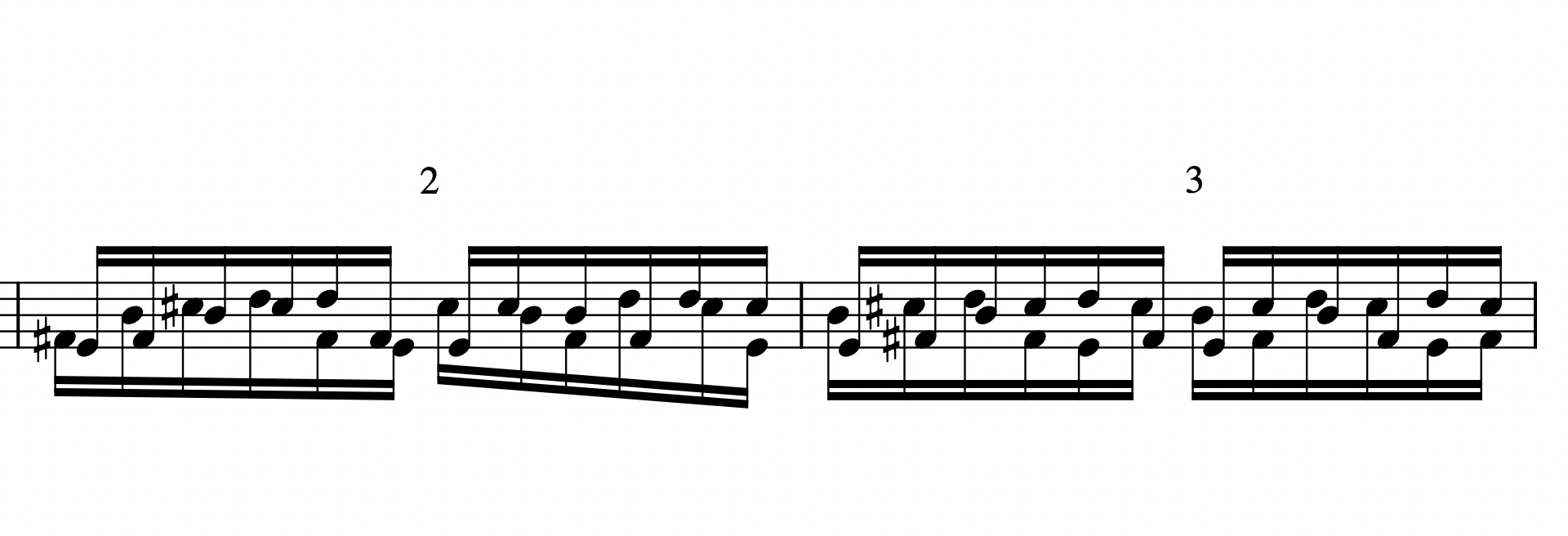
Looking at the vertical pitch relationship between the unison of the right and left hands at the beginning of the Piano Phase, it is obvious that they are playing the same phrase, so the set is monad.
Next, let's look at the pitch relationship in the musical notation of example [2] when the rhythmic phase between the second player and the first player, whose speed is played in a slightly faster loop, is off by a sixteenth note.
Analysis of the vertical intervals shows that, starting from the first beat, the intervals are 2nd, 4th, 2nd, 6th, 2nd, 6th, 2nd, 4th, 6th, 2nd, 6th and considering that the 4th was dissonant until the Renaissance, it is almost a dissonant interval except for the 6th. The time period of this two-voice combination can be regarded as a section where a kind of dominant, unstable and tense sound is produced.
Now let's look at an example of [3] with more sixteenth-note rhythmic lag on one of the voices.
The first six note patterns for the first half of the 6/8 time signature and the second six note
patterns for the second half of the 6/8 time signature are exactly the same phrase repeated.
In other words, we can say that a state in which the loop cycle of the rhythm pattern is halved
has suddenly appeared.
The vertical pitch interval relationship is a repetition of 5th, 5th, 3rd, 5th, 7th, and 5th,
with most of the intervals being consonant intervals.
This could be interpreted as a class in which a kind of tonic-like stable sound is produced.
Even a melodic sequence of notes that does not even include transpositions or changes of members, by stacking two of them and shifting their phases, various sounds are generated, and these transitions are shown to be music by being done gently and somehow.
The fact that dissonant and consonant sounds appear at times, creating the tension and relaxation
that are essential to music, can be attributed to the carefully calculated sound patterns
created by the composer, Reich.
This work may be viewed from the angle that it is formed by a melodic sequence of 12 notes as
data and an algorithm of superimposing them in rotation to form two voices, but unless the
sequence of notes is carefully chosen, the music will not result in a dramatic development.
In some parts, the music is monophonic but polyphonic, and in other parts, it is homophonic,
rhythmic, and requires skill in determining the sequence of notes to manipulate the sound.
Minimalism is not a simplification of music, etc., but rather a condensation of many things into
a minimum of sound.
And the most efficient way to prototype to determine the tone row would be to generate the
sounds by prototyping them into a program like Max/MSP.
ピアノフェイズの冒頭の右手と左手のユニゾンの縦の音程関係を見ると、当然同一のフレーズを演奏しているため集合はモナッドとなります。
次に、速度がやや早くループ演奏される二人目の奏者と一人目の奏者とのリズムの位相が時間にして16分音符分ずれたときの[2]番の譜例の音程関係を見てみましょう。
縦の音程を分析すると1拍目から順に2nd, 4th, 2nd, 2nd, 6th, 2nd, 6th, 2nd, 4th, 6th, 2nd, 6th となっており、ルネサンス期までは4thは不協和音であったことを考えると6th以外ほとんど不協和音程となっています。 この2声のコンビネーションの時間帯は一種のドミナントのような不安定で緊張感がある音響が生み出されるセクションと見なすことができます。
今度は更に16分音符分片方の声部のリズムが遅れた状態の[3]番の譜例を見てみましょう。
6/8拍子の前半6個分の音型と後半6個分の音型が全く同一のフレーズの繰り返しになっています。
つまりリズムパターンのループサイクルが半分になる状態が突然登場したとも言えます。
縦の音程関係を見ていくと、5th, 5th, 3rd, 5th, 7th,
5thの順番の繰り返しとなっており、ほとんどの音程は協和音程ととなります。
これは一種のトニックのような安定した音響が生み出されるクラスと解釈することもできるでしょう。
トランスポジションやメンバーの変更すら含まないメロディーの音列も、2つ重ねて位相をシフトしていくことによって、様々な響きが生じ、それらの変遷はなだらかにいつのまにか行われることで音楽として成立することを示しているのがこの作品です。
あるときは不協和な、またあるときは協和な響きが出現し音楽に必要不可欠である緊張と弛緩を生み出している点は、作曲家ライヒの綿密な計算によって生み出された音型に仕掛けがあるといえるのではないでしょうか。
この作品はデータとしての12音から構成されるメロディの音列と、それをローテーションさせて重ね合わせて2声を構成するというアルゴリズムによって成立しているという角度から見ることもできると思いますが、音列の選択は慎重に行わない限り、ドラマチックな展開が生じる音楽にはならないでしょう。
単旋律でありながらポリフォニックに、そしてある部分ではホモフォニックに、リズミックに
音を操るには音列の決定に技巧が必要であり、ミニマリズムは音楽を単純化したものなどではなく、多くのことが最小限の音に凝縮されているのではないでしょうか。
そして、その音列を決定するために最も効率的に試作を行う方法は、Max/MSPのようなプログラムにプロトタイプして音を生成していくことなのではないでしょうか。
Piano Phase with Max/MSP
Max/MSPで実装するピアノフェイズ
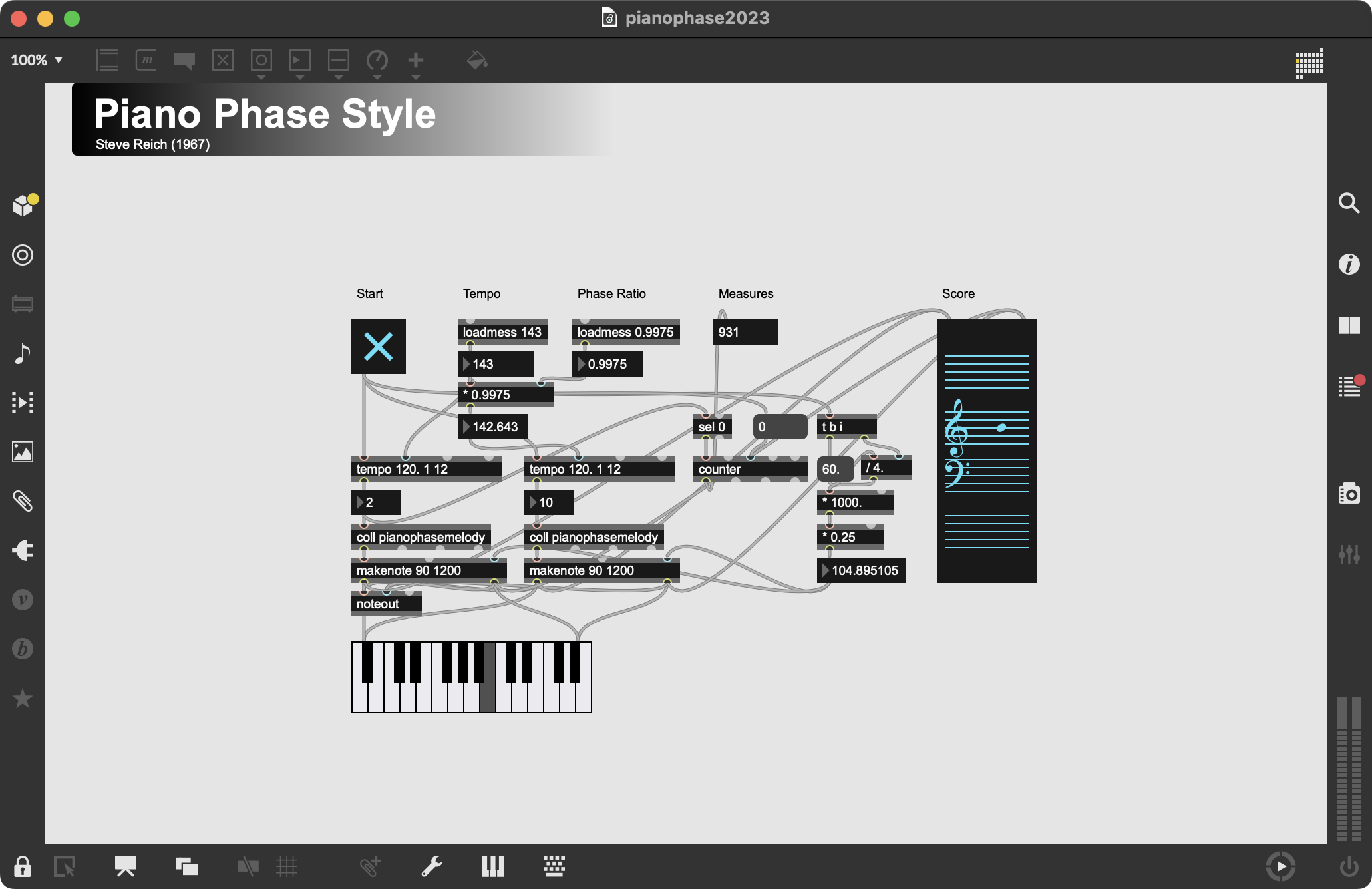
Free Download Max (or Ableton Max for Live) Patch Study Phasing Kit
When considering music that uses Max/MSP to perform phasing, the setting of the difference in tempo between the two voices is of the utmost importance. The tempo of the first piano is set to 143 and connected to the second inlet of the [tempo] object. The tempo of the other piano is set to 142.6425. This is done by connecting the [numbers] object to the [* ] object connected to the [numbers] object to automatically calculate the numbers.
If necessary, change the number 0.9975 in this section. It will change the pace at which the set
of dissonant and congruent classes shift.
Unlike human performance, where the tempo is adjusted while listening to the sound, phasing can
be done quite faithfully to theory. It is difficult to create this kind of music on a DAW, but
it can be achieved with fairly simple patches using a program like Max/MSP.
The [tempo] object generates numbers from 0 to 11 in the specified tempo rhythm. This is received
by the [coll] object and converted to midi note numbers.
The number converted here is the midi note number of the Piano Phase melody.
This is described in a file called pianophasemelody.txt, which must be placed in the same
directory as the maxpat or in a directory with a file path. This is all that is needed
to complete the phasing program.
Despite its minimal algorithmic structure, it is capable of producing such a large number of
acoustic variations.
It is also possible to rewrite and save pianophasemelody.txt to generate phase music consisting of 12 notes of your choice. Please try to run this program with a melody different from the piano phase.
Max/MSPを用いてフェイジングを実行するような音楽を考える場合、2声のテンポの差の設定が最も重要なポイントになります。 1つ目のピアノのテンポは143に設定され[tempo]オブジェクトの第2インレットに接続されています。もう一方のピアノのテンポは142.6425に設定されています。これは[numbers]オブジェクトに[* ]オブジェクトを接続し、数値を自動計算しています。
必要に応じてこの部分の0.9975という数値を変えてみてください。不協和なクラスと協和なクラスの集合の移り変わりのペースが変わります。
音を聞きながらテンポを調整してしまう人間の演奏とは異なり、かなり理論に忠実なフェイジングを行うことが可能です。このような音楽をDAWで作るのは大変ですが、Max/MSPのようなプログラムを使えばかなりシンプルなパッチで実現可能です。
[tempo]オブジェクトは指定されたテンポのリズムで、0から11までの数値を生成します。これをcollオブジェクトで受信し、midiノートナンバーに変換しています。
ここで変換される数値はPiano
Phaseで採用されているモノフォニックな音型です。
これはpianophasemelody.txtというファイルに記述されていますが、このファイルはMaxの実行ファイルと同じディレクトリーもしくはファイルパスが通っているディレクトリーに置く必要があります。これだけでフェイジングのプログラムは完成です。
アルゴリズムに関しても最小限の構造であるにも関わらず、これだけの多くの音響のバリエーションを生み出すことが可能です。
pianophasemelody.txtは書き換えて保存することで自分が好きな12音から成るフェイズ音楽を生成することも可能です。ぜひピアノフェイズとは異なるメロディーでこのプログラムを動かすことに挑戦してみてください。
Demo
デモ
Conclusion
おわりに
What do you think about creativity through a program that performs phasing using Max/MSP?
In the case of this kind of music generation, is it really composer's job to invent an
algorithm, or is it composer's job to refine the output of an existing algorithm by feeding it
with some data?
Just as there are two directions in the world of primary creators, who explore rough but
uncharted territory, and secondary creators, who diligently refine established expressions,
there may be two major vectors in composition.
There is no answer here. Please think for yourself..
Max/MSPを使ってフェイジングを実行するプログラムを通じてみなさんは創造性についてどのように考えるでしょうか。
こういった音楽の生成の場合、はたしてアルゴリズムを発明することが作曲家の仕事であるのか、それとも、既存のアルゴリズムに対して、なんらかのデータを与えて出力を洗練させていくのが作曲家の仕事であるのか。
それは荒削りではあるものの未知の領域を開拓するプライマリークリエイターと、定着した表現をひたすら洗練させるセカンダリークリエイターの世界が2方向あるように、作曲にも二つの大きなベクトルが存在しているのかもしれません。
ここに答えはありません。皆さん自身の頭で考えてみてください。
Reference
Joseph N Straus. Introduction to Post-Tonal Theory. Pearson https://www.pearson.com/en-gb/subject-catalog/p/introduction-to-post-tonal-theory-pearson-new-international-edition/P200000008899/9781292055565
Peter Burkholder, Donald Jay Grout, Claude V Palisca. A History of Western Music. W W Norton & Co Inc https://wwnorton.com/books/9780393668179
Dennis DeSantis. Making Music Creative Strategies for Electronic Music Producers. Ableton https://makingmusic.ableton.com


